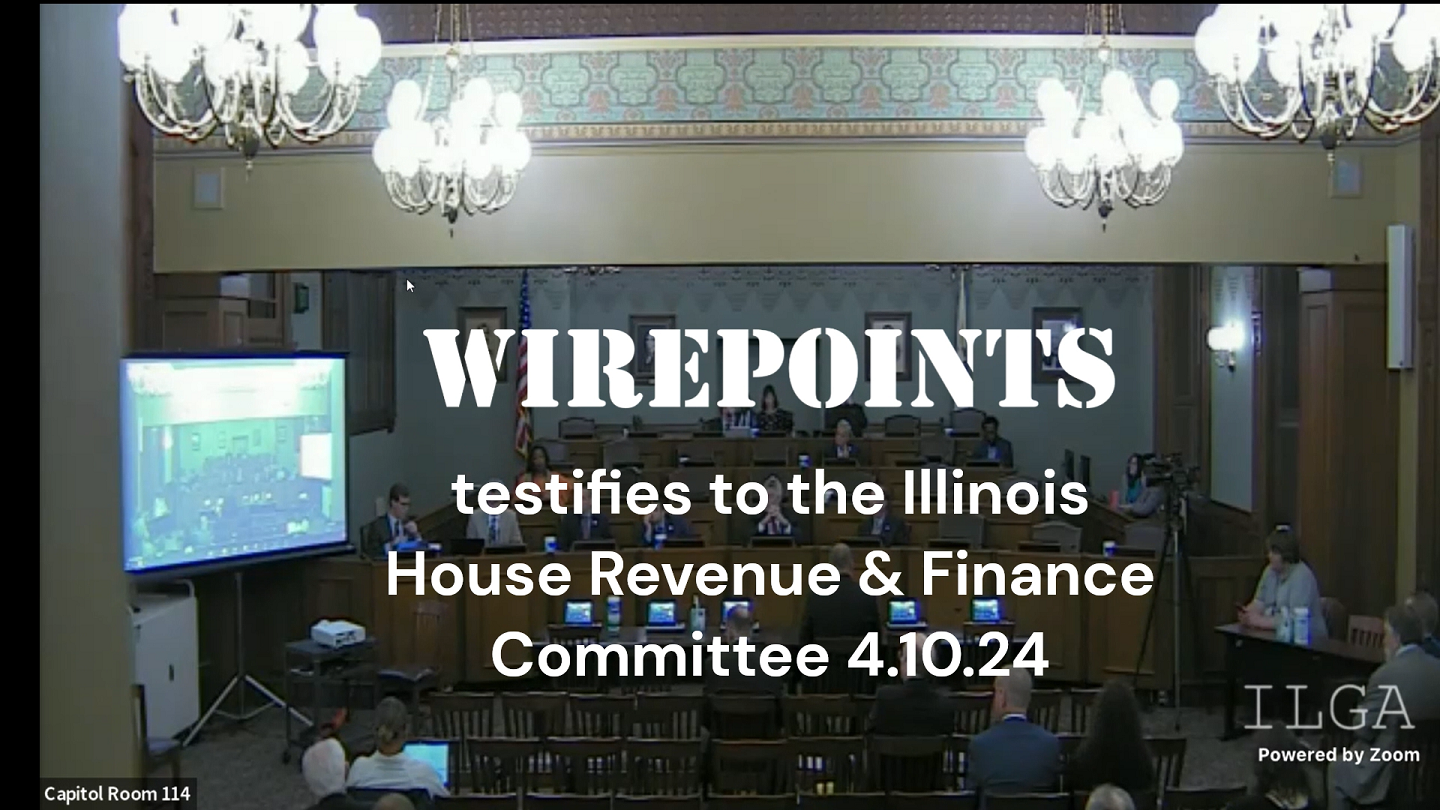“Gall: Brazen boldness coupled with impudent assurance and insolence.”
– Merriam-Webster Dictionary
By: Mark Glennon*
IMRF, the Illinois Municipal Retirement Fund, went on a “statewide informational tour” last week. It was basically a brag fest. Illinois taxpayers should be appalled.
IMRF is the second largest pension fund in the state. It covers 100,000 employees and retirees of 3,000 Illinois municipalities who are not policemen, firefighters and those covered by state pensions. Among its boasts is that it will be reducing contributions made by municipal employers from 11.73% of payroll to 11.34%. Also, it’s “well funded,” in its words — about 87 % funded — far higher than most state and municipal pensions in Illinois.
Here’s why taxpayers should find IMRF’s grandstanding galling:
• If you’ve been wondering why Illinois has the highest property taxes in the nation, often exceeding a suicidal four percent, count IMRF as one reason. IMRF is unique among Illinois state and municipal pensions because it’s empowered to force municipalities to raise property taxes to keep its funding up. That crowds out money for libraries, roads, schools, you name it. Taxpayers pay $2.50 for every $1.00 that IMRF member pay into their pensions, far higher than is typical in the private sector. Most IMRF retirees get Social Security, too, into which both they and municipalities contribute. For IMRF, municipalities around the state don’t face the impossible choice of either underfunding or raising taxes to cover contributions — as they do with police and fire pensions. IMRF just sends a bill for whatever it takes, which goes into property taxes.
• Even with its comparatively high funding level, IMRF is still short about $5 billion, which taxpayers will be on the hook for. Dropping employer contribution rates means little with taxpayers in hock for that $5 billion plus whatever else accrues.
• IMRF offers its members, in addition to their pension, a “guarantied” 7.5% annual return savings account, effectively at taxpayer expense. As any saver today knows, guarantied long term rates are far lower than that (under 2.7%). Guess who guaranties the difference? Property tax payers. As with the pension obligations, IMRF can force automatic property tax increases as necessary to cover that savings account. We wrote in detail about those 7.5% accounts earlier.
• IMRF members also get a “13th payment,” notorious in the pension world. That’s a sort of bonus check once a year in addition to their monthly pension payments, paid entirely by taxpayers, according to IMRF’s site. It cost $42 million last year. A coalition of public unions gloated two years ago about killing a bill that might have ended it.
• IMRF’s accrued pension benefits have been growing at the pace of 7.2 percent a year since 2000, according to the Illinois Policy Institute, far faster than the 2.3 percent rate of inflation and beyond what city taxpayers can afford.
• IMRF attributes its supposed success largely to the Tier 2 pension reforms, which it praises. They should be embarrassed if that’s what’s helping them look good. The Tier 2 pension reforms of 2010 are a disaster. They were “bulldozed through” the legislature by House Speaker Michael Madigan with no understanding of the consequences. Tier 2 employees — those hired after 2010 — pay in the same portion of their paychecks even though the cost of their benefits is 40% less than Tier 1 employees because Tier 2 benefits are far less than Tier 1’s. We’ve written in detail about the myriad problems in the Tier 2 “reforms,” linked here, here and here. The General Assembly has a legislative task force trying to figure out how to fix Tier 2 problems. We haven’t heard a peep on that, probably because they are stumped.
• IMRF continues to peddle numbers about its positive economic benefit, but it looks at only one side of the equation. Eighty-five percent of its retirees remain in Illinois after they retire, supporting the the creation of nearly 16,000 jobs and $600 million in additional salaries, it gloats. Yeah, well, 100% of that money would have been spent in Illinois had municipalities been able to spend it on other services and there’s no reason to think that any fewer jobs would have been supported had the money been left with taxpayers to spend as they choose. IMRF measures only one side of the issue.
• Why did IMRF, alone, get the right to force funding to keep it relatively healthy while cops and firefighters in many towns an cities face the certainty of having their pensions go broke? Who knows, but maybe it had something to do with mayors, county board members and other top brass politicos being in IMRF.
• “Spiking” — jacking up end-of-career pay in order to artificially jack up the pension — is a recurring problem with IMRF members. The General Assembly is now considering special legislation to try to control it.
• Members are supposed to work a minimum number of hours per year to get a pension, but questions persist about how well that’s enforced. As reported last week, some members of one county board weren’t even aware of that requirement.
The press is routinely suckered by IMRF’s propaganda. WTTW’s Chicago Tonight show has featured, at least twice, IMRF representatives showboating as a model of a successful pension, and they go unchallenged. The Rockford Register Star last week praised IMRF, saying it puts other pensions to shame. (They also repeated the absurd myth that 80% funding is healthy for a pension.)
IMRF is no model pension. It is, as Taxpayers United of America put it, “the gold standard in taxpayer abuse.”
*Mark Glennon is founder of WirePoints. Opinions expressed are his own.

 Chicago Public Schools is failing its students in almost every way. What can be done to save the educational futures of Chicago’s children? Join Wirepoints’ Ted Dabrowski as he participates in an education roundtable discussion hosted by Seeking Educational Excellence (SEE).
Chicago Public Schools is failing its students in almost every way. What can be done to save the educational futures of Chicago’s children? Join Wirepoints’ Ted Dabrowski as he participates in an education roundtable discussion hosted by Seeking Educational Excellence (SEE). If you’re frustrated with Illinois’ educational results, you may want to follow the money from teachers unions. In the last four years alone, Illinois lawmakers and political candidates have taken nearly $30 million in contributions from teachers unions and their national affiliates.
If you’re frustrated with Illinois’ educational results, you may want to follow the money from teachers unions. In the last four years alone, Illinois lawmakers and political candidates have taken nearly $30 million in contributions from teachers unions and their national affiliates.
 Wirepoints President Ted Dabrowski testified on April 10, 2024 to members of the House Revenue and Finance Committee at the invitation of Rep. Joe Sosnowski. Ted told lawmakers that the state’s property tax burden has become dire for countless Illinoisans.
Wirepoints President Ted Dabrowski testified on April 10, 2024 to members of the House Revenue and Finance Committee at the invitation of Rep. Joe Sosnowski. Ted told lawmakers that the state’s property tax burden has become dire for countless Illinoisans.
After reading this article, I have come to the conclusion that the writer knows very little how IMRF actaully works. It’s a LONG TERM conservative investment strategy that over the past 5 years has provided 7.78% return. 87% funding is considered actuarially fully funded. Seeing s there are over 7000 units of Government in IL, and only 3000 are in IMRF, tells me that if a Govt. does not want to be in IMRF they don’t have to. I don’t claim to know how that would work, but I suppose they could not enroll new hires in IMRF and let… Read more »
100% funding is fully funded.
Chronically underfunded is not fully funded.
Once a unit of government opts into IMRF, they cannot opt out.
An employee in a unit of government participating in IMRF must participate in IMRF if the employee meets IMRF participation criteria.
Read the IMRF document, “Is Your Unit of Government Thinking About Joining IMRF?”
Be sure to read the part explaining how an employee can buy service credit for years worked prior to the unit of government joining IMRF.
MJPrice, regarding your long term return expectations, I suggest you start by reading what a couple Nobel Price economists say: https://wirepoints.org/harshest-critics-of-public-pensions-are-nobel-prize-winning-economists-wp-original/
As for your claim that 87% is fully funded, see what the American Academy of Actuaries says. 100% is fully funded. IMRF says that on its site. You either have the money you need or you don’t:
https://www.google.com/url?sa=t&rct=j&q=&esrc=s&source=web&cd=1&ved=0ahUKEwjj1aqx-M_MAhVlyoMKHc8gB6MQFggnMAA&url=https%3A%2F%2Fwww.actuary.org%2Ffiles%2F80_Percent_Funding_IB_071912.pdf&usg=AFQjCNF6lXsvm9taDQ8ImfkUvDFIUzBLdw&sig2=Tk8d2jz-192r_2_Vd31DEw
There is indeed one way that IMRF “works”: Most people have been duped like you have, which is why this catastrophic pension system is bankrupting us.
If done properly?! Gotta love that one. Yeah, MJ, maybe ALL public sector pensions should have the same legal right to force the pension payments at the expense of everything and everyone else. That way, we could send every municipality into insolvency at warp speed instead of this slow grind. The bottom line is very simple: the public sector has betrayed the trust of taxpayers for years and years and years, and everyone knows it. Not to worry, though. The taxpayers are going to return the favor, in spades, and there will be no sympathy when it happens. Sooner or… Read more »
Technically, IMRF’s COLA calculation is 3% simple interest plus the 13th payment, whereas TRS/SURS/etc is 3% compounded interest. If you do the math (and I did), IMRF’s COLA calculation is actually more expensive than compounded COLA in the first dozen years of retirement and holds a cumulative advantage (depending when you retired) up to nearly 20 years. The only reason it isn’t longer is because the % used to calculate the 13th payment is decreases every year because it’s based on active/retiree ratio and – wouldn’t you know it – retirees are living longer and outnumbering the actives, to the… Read more »
nixit71,
You said, “wouldn’t you know it – retirees are living longer and outnumbering the active”. Last numbers I saw, active member numbers were at 180,000 and retirees were at 93,262.
Tim, you’re right, the 13th payment is calculated based on a % of payroll and not the # of actives. That said, the # of retirees is growing faster than the # of members actively working, so the same principle still holds true.
I think that only stands to reason, don’t you? Municipalities are cutting back on new hires and turning full time positions into part time positions for the purpose of cutting benefits, insurance, pensions, etc. So, eventually yes, retirees will indeed catch up to active members.
But doesn’t that reiterate Mark’s initial point about IMRF benefits crowding out funding for services today? Since the locals cannot short their ever-increasing pension payments to fund services today like the state does, they are attempting to control their costs via employment status (less hires, more outsourcing, etc). What you are witnessing at the local level is exactly what would’ve happened at the state level had they lived by the same rules as IMRF: Less state employees, all earning less, resulting in smaller pensions.
100% correct nixit. Another thing public sector workers don’t see coming is the massive shifts in demographics. Millenials, Generation X, and Tier2 level employees will soon make up the majority of the workforce. I wonder how long Tier 2 employees will be willing to make sacrifices for their union comrades who had no trouble throwing them under the bus to protect themselves. Mark my words: ALL bubbles implode, and when they do, IRONY is always a cruel visitor.